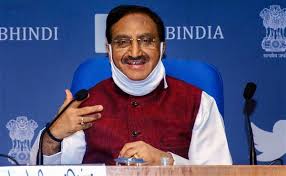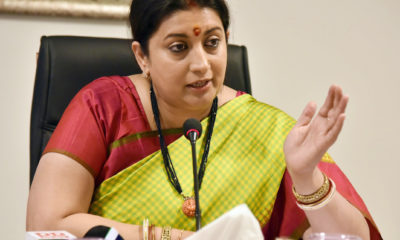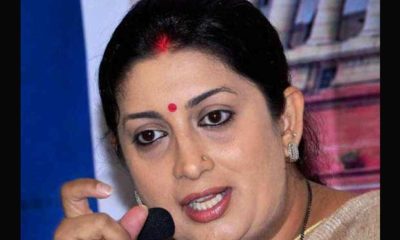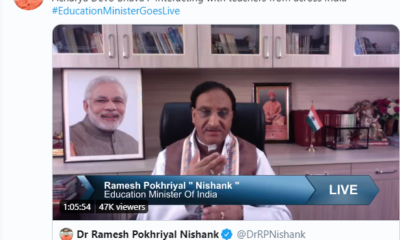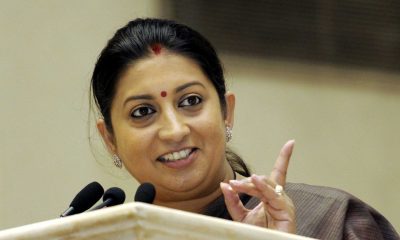Feature
National education policy to be prepared with opinion of all: Irani

Agartala: Union Human Resource Development Minister Smriti Irani has said a joint effort has been initiated from the national to the grassroots level to obtain opinion to formulate a national education policy.
“This is for the first time citizen of India at large from national to grassroots level would give their opinion in preparing the national education policy. The draft of the policy would be ready by December,” Irani told reporters on Friday night after meeting Tripura Chief Minister Manik Sarkar.
She said: “The first regional meeting covering all the eight northeastern states held in Agartala Friday. The education ministers and representatives of these states gave their views on the proposed national education policy.”
The minister, who left for Delhi on Saturday, said the gram panchayat level to district, state to national level consultation on the education policy already begun across the country and the response was very enlightening.
On Friday, addressing the students and teachers of the National Institute of Technology (NIT), Agartala, she said to obtain experiences and expertise by the IIT and NIT students from world famous scientist, academician and technical experts, the MHRD has recently launched a scheme ‘GIAN’ (Global Initiative of Academic Network).
She asked the institute to provide a list of foreign experts, who can be invited.
“The travel and other cost of the guest expert would be borne by my ministry and the deliberations would be video recorded for future use by the students,” she announced.
Irani also asked the all concerned to share experience among the students of various NITs and IITs of the country and requested the NIT students to share their experience, knowledge and inventions with the people living adjoining the villages of their institute.
She also announced that a web portal “e-soudh-sindhu” would be launched by January next year and over 90,000 e-books and 10,000 journals of across the world would be available in the plat form.
The minister accompanied by HRD Secretary V.S. Oberoi (Higher Education) and S.C. Khuntia (School Education) held a meeting here on Friday with the education ministers of the northeast states to discuss the proposed national education policy.
Tripura Education Minister Tapan Chakraborty said the Friday’s meeting was held as the follow up meeting of the 63rd meeting of the Central Advisory Board of Education (CABE) that was held in New Delhi on August 19.
He told reporters that in the CABE meeting, most northeast states wanted to remove the ‘no-detention policy’ at the elementary school level (up to class 8).
Chakraborty said: “The eight northeast states along with most states of the country are not only against the ‘no-detention policy’ but are also in an awkward position due to the lack of trained teachers even though the Right to Education Act (RTE), 2009, made this mandatory.”
The minister said the Left Front government strongly supported the plan for a new education policy, a process initiated by the Bharatiya Janata Party-led National Democratic Alliance government.
Entertainment
Meghalaya Reserves Legalized Gambling and Sports Betting for Tourists

The State Scores Extra High on Gaming-Friendly Industry Index
Meghalaya scored 92.85 out of 100 possible points in a Gaming Industry Index and proved to be India’s most gaming-friendly state following its recent profound legislation changes over the field allowing land-based and online gaming, including games of chance, under a licensing regime.
The index by the UK India Business Council (UKIBC) uses a scale of 0 to 100 to measure the level of legalisation on gambling and betting achieved by a state based on the scores over a set of seven different games – lottery, horse racing, betting on sports, poker, rummy, casino and fantasy sports
Starting from February last year, Meghalaya became the third state in India’s northeast to legalise gambling and betting after Sikkim and Nagaland. After consultations with the UKIBC, the state proceeded with the adoption of the Meghalaya Regulation of Gaming Act, 2021 and the nullification of the Meghalaya Prevention of Gambling Act, 1970. Subsequently in December, the Meghalaya Regulation of Gaming Rules, 2021 were notified and came into force.
All for the Tourists
The move to legalise and license various forms of offline and online betting and gambling in Meghalaya is aimed at boosting tourism and creating jobs, and altogether raising taxation revenues for the northeastern state. At the same time, the opportunities to bet and gamble legally will be reserved only for tourists and visitors.
“We came out with a Gaming Act and subsequently framed the Regulation of Gaming Rules, 2021. The government will accordingly issue licenses to operate games of skill and chance, both online and offline,” said James P. K. Sangma, Meghalaya State Law and Taxation Minister speaking in the capital city of Shillong. “But the legalized gambling and gaming will only be for tourists and not residents of Meghalaya,” he continued.
To be allowed to play, tourists and people visiting the state for work or business purposes will have to prove their non-resident status by presenting appropriate documents, in a process similar to a bank KYC (Know Your Customer) procedure.
Meghalaya Reaches Out to a Vast Market
With 140 millions of people in India estimated to bet regularly on sports, and a total of 370 million desi bettors around prominent sporting events, as per data from one of the latest reports by Esse N Videri, Meghalaya is set to reach out and take a piece of a vast market.
Estimates on the financial value of India’s sports betting market, combined across all types of offline channels and online sports and cricket predictions and betting platforms, speak about amounts between $130 and $150 billion (roughly between ₹9.7 and ₹11.5 lakh crore).
Andhra Pradesh, Telangana and Delhi are shown to deliver the highest number of bettors and Meghalaya can count on substantial tourists flow from their betting circles. The sports betting communities of Karnataka, Maharashtra, Uttar Pradesh and Haryana are also not to be underestimated.
Among the sports, cricket is most popular, registering 68 percent of the total bet count analyzed by Esse N Videri. Football takes second position with 11 percent of the bets, followed by betting on FIFA at 7 percent and on eCricket at 5 percent. The last position in the Top 5 of popular sports for betting in India is taken by tennis with 3 percent of the bet count.
Local Citizens will Still have Their Teer Betting
Meghalaya residents will still be permitted to participate in teer betting over arrow-shooting results. Teer is a traditional method of gambling, somewhat similar to a lottery draw, and held under the rules of the Meghalaya Regulation of the Game of Arrow Shooting and the Sale of Teer Tickets Act, 2018.
Teer includes bettors wagering on the number of arrows that reach the target which is placed about 50 meters away from a team of 20 archers positioned in a semicircle.
The archers shoot volleys of arrows at the target for ten minutes, and players place their bets choosing a number between 0 and 99 trying to guess the last two digits of the number of arrows that successfully pierce the target.
If, for example, the number of hits is 256, anyone who has bet on 56 wins an amount eight times bigger than their wager.


